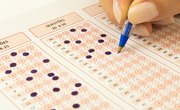Trivia games are excellent review materials for students. It takes away the pressure that students usually feel when taking tests and can also foster teamwork within the classroom. Teachers facilitating trivia games can group students into teams to facilitate camaraderie and cooperation, and classroom trivia games can make review sessions more interesting.
Classic Jeopardy Trivia Game
Classic Jeopardy is a popular trivia game to introduce to a classroom. It is also a good way to review concepts and facts in all kinds of subjects since the questions are formed in answers. This makes sure that students remember the details of specific information.
Teachers can group questions from easy, intermediate and difficult with the points increasing with the difficulty. Draw the game board, which is composed of boxes with points in them, on the classroom's whiteboard or project it from a computer. For example, as the questions in each category get more difficult, the points in each category get bigger.
Teachers can group students into teams to make the game more interactive. The game starts when the teacher chooses the first easy box that teams need to answer. Once the first box has been answered, the team that answered correctly can choose the next question. They can choose the hardest questions if they want additional points or they can opt for easier ones for lower amounts of points.
For the final round, also known as "Double Jeopardy," the points double. The game ends when all the questions on the board game have been answered and the team with the highest score wins.
Snakes and Ladders Trivia Game
This game is adapted from the classic snakes and ladders board game. Prepare questions that range from easy to hard and designate a corresponding point for each question. Don't forget to add negative points for every wrong answer.
For example, an easy question answered correctly corresponds to one point, but giving a wrong answer corresponds to one negative point, making the team's pawn move back one step. Students are grouped into several teams ,and they need to choose a representative that will play as the team's pawn or token. Prepare a 10- or 20-step "board game" in the classroom and make the pawns stand at the start button. The team who gets to the finish line first wins.
Puzzle Trivia Games
Use a puzzle trivia game in subjects like U.S. geography. The goal of the game is to test if students remember the location of states. Draw a map of the United States on a board, not including the names of the states. To make the game more interesting, do not mention the exact name of the state while giving out information.
For example, you can ask questions like "what is the second biggest state in the United States in terms of land mass." Students answering the question need to name the state and at the same time label its place on the map. If students are familiar with the map, they will be able to spot the location of the right state, which is Texas. You can also use this puzzle trivia game when teaching science lessons, such as the parts of the human body.
Online and Computer-based Trivia Games
Some students enjoy interactive computer trivia games rather than classroom activities. Fortunately there are a lot of choices that teachers can download and try.
Most computer-based trivia games imitate the rules of popular TV games like "Who Wants to Be a Millionaire," "The Weakest Link" and "Family Feud." Some computer-based trivia games are highly customizable, allowing a teacher to format the questions according to the lessons he or she introduces to the class.
Related Articles
Writer Bio
Steve Johnson is an avid and passionate writer with more than five years of experience. He's written for several industries, including health, dating and Internet marketing, as well as for various websites. He holds a bachelor's degree from the University of Texas.










